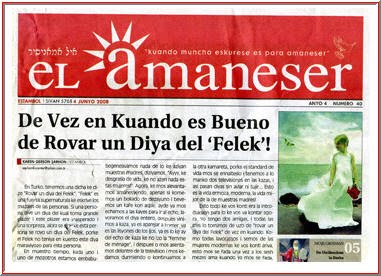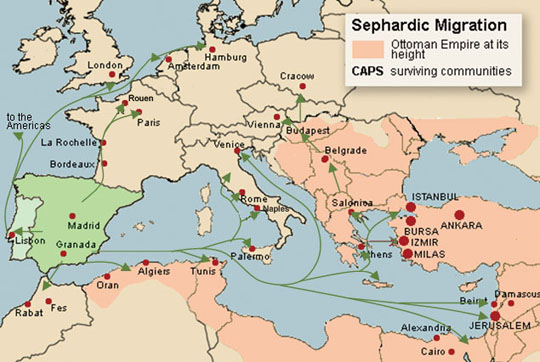With over 20 official Spanish speaking countries, few people know of another Spanish language: Ladino. The language is also known as judeo-español, Djudeo-Espanyol, Djudeo-Kasteyano, Judezmo, Djudezmo, Spaniolit, and גודיאו-איספאנייול.
No, it’s not Latino.
It’s not Latin.
It’s Ladino, the language of the Jews expelled from Spain and Portugal at the time of the Inquisition. The Ottoman Empire invited Sephardic (Spanish) Jews to its lands. Those Jewish communities kept their old Spanish language and to this day there are still people in Turkey, the Balkans and Israel who speak the language. Unfortunately, most Ladino speakers are elderly and haven’t maintained the language with their children. Thus, this form of Spanish, with its Turkish, Greek and other linguistic influences, is on the road to linguistic extinction.
Why preserve the language? It can save a life.
You may wonder why someone living in Bulgaria or Bosnia would bother to maintain a language from a country from which his or her ancestors were expelled. The same question could be asked of my parents who forced me to learn Russian despite their having left the former Soviet Union as traitors to Communist paradise. You could also ask Cubans who fled Fidel Castro’s Communism why they fervently maintain Spanish in the United States. The reasons for maintaining languages abound but I will give one dramatic example of how speaking Ladino saved a young Bosnian Jewish boy’s life in World War II.
When I lived in Sarajevo, Bosnia after the Bosnian war, I met several elderly Bosnian Jews who spoke Ladino at the La Benevolencija Synagogue. Ladino sounded gentle and lush with music and passion. I had to listen carefully to understand because the men used old Spanish words like fazer and lavorar that are close to modern Portuguese and Italian words.

Amongst the Ladino speakers was a very energetic former pilot who spoke excellent English. He was about ten years old when the Croatian army (allied with Hitler) boarded Sarajevo Jews in trains to be sent to concentration camps. At one of the stops in Croatia, his parents took out the boards at the bottom of the train car and made him run out alone and disappear into the crowds. They correctly figured that a little boy could quickly run and hide at the train stop. Alone, he ran out onto the platform and one of his former Bosnian Croat teachers spotted him. His teacher was now a soldier in the Croatian army and didn’t want the boy to be sent to the gas chambers. So the teacher told him to get into a truck driven by an Italian soldier who could take him into a mountain area where other Jewish kids were living in hiding. The teacher could not take the boy himself to the truck because he didn’t want to be caught helping a Jewish boy escape because his job was to make sure the trains of Jews went to their destination, the concentration camps.
How do you think the little boy who only knew Bosnian (Serbo-Croatian) and some Ladino could communicate with the Italian soldier?
Ladino.
Yes, he used an ancient Spanish, brought by his family almost 500 years prior, to speak to the Italian army driver. The languages were close enough that the boy and soldier could speak to each other and for the Italian soldier to know where to drive the Bosnian Jewish boy so that he wouldn’t be sent to his death in a Nazi extermination or concentration camp.
From what the pilot described, his “camp in the woods” was really a no man’s land for children who lived on their own for two years, reminding me of William Golding’s book, Lord of the Flies, without the savagery described in the book. (The number two sticks in my mind but I don’t know where he went after those two years.) I think they received food donations from neighboring villages or charities but I don’t remember the details. Who would have thought that an antiquated version of Spanish could help save someone’s life during a war?
If the boy hadn’t been able to express himself in Ladino to the Italian soldier, who knows what might have been his demise. Perhaps he would have been caught and put on a train to a concentration camp.
There’s no need to say anymore about why maintaining languages, ancient as they are, is vital. We need our languages to survive.
Musical revivals, Ladino cultural institution
It’s not all gloomy for the Ladino language, there are places where the language is being preserved, or at least maintained.

My friend Montserrat Franco, studied Ladino music in Spain and Israel, and gives concerts of Ladino music. By clicking on the titles, you can hear her singing these Ladino kantigas (songs): Mes de Mayo, Scalerika d’Oro and La Serena.
In the California Bay Area, I sometimes attend concerts by Kat Parra who sings Ladino music with the Sephardic Music Experience.

When I was in Istanbul recently, I tried to connect with the Ladino community at the Istanbul Sephardic Center but as I arrived in the city during a national holiday (Bajram) and all offices were closed, I couldn’t meet anyone in the community and hear the beautiful luscious tones of the Ladino language. The website of the Istanbul Sephardic Center has a page in Djudeo-Espanyol. If you speak Spanish, you can understand the language although the spelling is different from modern Castillian Spanish.
I end this blog post with part of a classic Ladino song, Adio Kerida, sung by Yasmin Levy, a young Ladino singer in Israel is reviving the language in her new flamenco versions of popular Ladino songs. Although the song is sad in its nature, it brings tears to my eyes, not because of the lyrics, but because it is so touches me profoundly to see a crowd of people in modern day Spain singing this Ladino classic along with Levy. There are English subtitles with the video.
The language is alive!
(The list of comments after the video are filled with racist banter and it’s best not to pay attention to them.)














Fascinating story. All we Spaniards can do to revive the ties between the Sephardim and Spain wouldn’t be enough. Imagine if England had a community of people who had preserved the language as spoken by Shakespeare. That’s what we have with the ladinos.nnRadio Nacional de Espau00f1a has podcasts in Sephardic:u00a0http://www.rtve.es/alacarta/audios/programa/emision-sefardi-juderia-jaen-nueva-fusion-con-sefarad-israel-05-12-11/1266560/n
Jose, Thanks for the link to Radio Nacional Española. I had no idea that there was a program like that on National Spanish Radio. I enjoyed listening to some of the podcasts to hear Ladino spoken.
wow love your stories great blog !!
Hola!
Soy español y me parece super interesante todo la historia del Ladino. He crecido en España durante toda mi vida, pasando por el colegio, el instituto y la universidad y jamás me contaron nada sobre el Ladino. Lo único que recuerdo, cuando estudiaba la historia de España, es que los musulmanes fueron expulsados del país para poder restaurar el cristianismo, de forma que sonaba super triunfal, dando a entender que unos eran los buenos y otros los malos. Me avergüenzo sobremanera por ello, aunque yo no haya tenido nada que ver con lo que pasó años atrás.
Las canciones en Ladino son muy bonidas, en efecto, y puedo entender todo al 100%. Quizá me ponga en un ratito a aprender Ladino, ya que creo que en una tarde podría hablarlo perfectamente.
Un saludo y gracias por compartir esto.
Es una gran pena, es más, es una verguenza total que en España se sabe tan poco de la expulsión de los musulmanes y judíos del país y de lo que España perdió cuando los reyes decidieron que todos tenían que ser católicos. El gobierno español ha cambiado las leyes inmigratorias para facilitar la inmigración de los sefaradíes.
Me parte el corazon que tan pocas personas en el mundo hispano sepan que el ladino existe y que el idioma tenga este reportorio de canciones tan lindas. Espero que el documental que estoy produciendo sobre la vida de Moris pueda ayudar a que este idioma no desaparezca del mundo. Aquí se puede ver nuestro “demo” del documental: https://www.youtube.com/watch?v=xmh1SLRyA_Q.